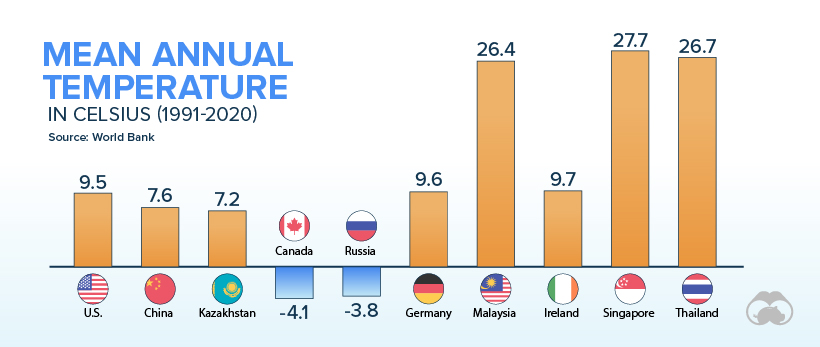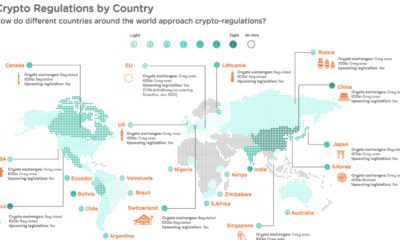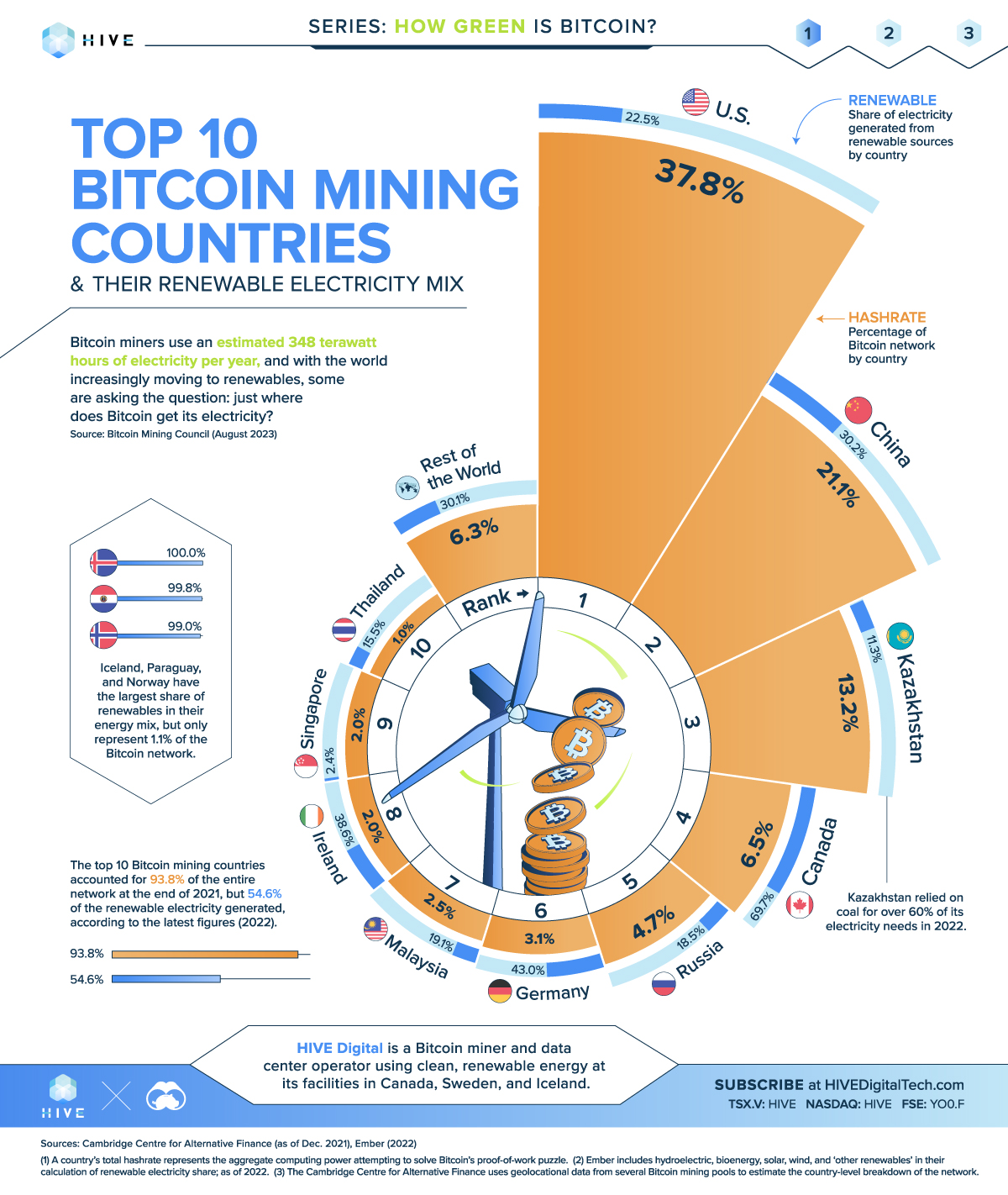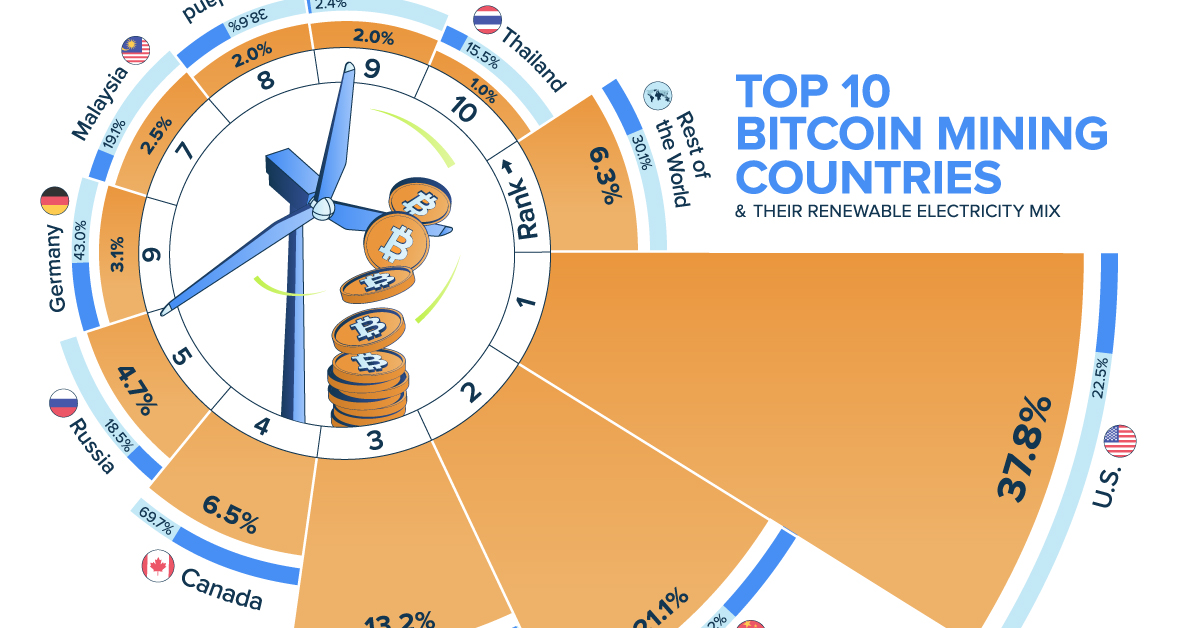Top 10 Bitcoin Mining Countries & Their Renewable Electricity Mix
Top 10 Bitcoin Mining Countries & Their Renewable Electricity Mix
Bitcoin miners use an estimated 348 terawatt hours of electricity per year, and with the world increasingly moving to renewables, some are asking the question: just where does Bitcoin get its electricity?
To answer that question, we partnered with HIVE Digital to visualize data from the Cambridge Centre for Alternative Finance and Ember, a climate-oriented energy think tank, to look at the Bitcoin network’s electricity mix.
This is part one in our How Green is Bitcoin? series, which examines the cryptocurrency’s sustainability.
The World According to Bitcoin
The top 10 countries for Bitcoin mining represent 93.8% of the entire network by hashrate—a measure of computational power—with the U.S., China, and Kazakhstan rounding out the top three. Together these three countries hosted nearly three-quarters of the network at the end of 2021.
| Country | Hashrate (%) | Renewable (%) |
|---|---|---|
| U.S. | 37.8% | 22.5% |
| China | 21.1% | 30.2% |
| Kazakhstan | 13.2% | 11.3% |
| Canada | 6.5% | 69.7% |
| Russia | 4.7% | 18.5% |
| Germany | 3.1% | 43.0% |
| Malaysia | 2.5% | 19.1% |
| Ireland | 2.0% | 38.6% |
| Singapore | 2.0% | 2.4% |
| Thailand | 1.0% | 15.5% |
| Rest of the World | 6.3% | 30.1% |
Source: Hashrate (%): Cambridge Centre for Alternative Finance as of December 2021; Renewable (%) Ember, as of 2022.
China used to be the top spot for Bitcoin mining, up to 75% of global capacity, but a crackdown in the summer of 2021 saw their share drop to nil in just a couple months. Many miners relocated to nearby Kazakhstan, attracted by cheap electricity, loose regulations, and a ‘stable’ political climate, while others opted for the United States. A sizable covert mining scene has also emerged in China, now that the dust has settled.
At the bottom of the top 10 are Ireland, Singapore, and Thailand, which together host 4.9% of the network. Ireland’s reported share—and this applies to sixth-place Germany, as well—is thought to be a significant overstatement caused by miners in other countries masking their true locations.
The Role of Renewables
On a national basis, the U.S., China, and Kazakhstan each had renewable shares of 22.5%, 30.2%, and 11.3% respectively. For context, renewables made up 30% of the world’s electricity generation in 2022 (not including nuclear).
Kazakhstan’s dismal renewable share is due to their heavy reliance on coal (60%), which is also a major export of the central Asian country. At the same time, coal contributes a similar amount of the electricity in China (61%), but their overall renewable share is higher because of their breakneck expansion of wind and solar power.
Wagons Ho?
Just where a Bitcoin miner sets up their rig is important, because unlike many other industries with factories or big head offices, they are mobile (Google ‘Bitcoin mining shipping containers’ if you need convincing).
Where they choose to put out their shingle is based on things like the regulatory regime, price of electricity, and because Bitcoin rigs generate a lot of heat, the average outdoor temperature. On this last point, here is how the top 10 breaks down by mean annual temperature:

Increasingly, though, with climate change driving the push to renewables, many Bitcoin miners are looking more closely at where their electricity is coming from. This could be why Canada—with its embarrassment of hydroelectric riches—has crept up the ranking from less than one percent of the network in 2019, to six-and-a-half percent at the end of 2021.
But considering that top renewable countries such as Iceland, Paraguay, and Norway together only hosted just over one percent of the global network, there’s still a lot more room left for growth.

Learn more about how Bitcoin miner and data center operator HIVE Digital is using clean, renewable energy at its facilities in Canada, Sweden, and Iceland.

-

 Energy3 years ago
Energy3 years agoVisualizing the Power Consumption of Bitcoin Mining
Bitcoin mining requires significant amounts of energy, but what does this consumption look like when compared to countries and companies?
-

 Bitcoin3 years ago
Bitcoin3 years agoBitcoin is Near All-Time Highs and the Mainstream Doesn’t Care…Yet
As bitcoin charges towards all-time highs, search interest is relatively low. How much attention has bitcoin’s recent rally gotten?
-

 Technology5 years ago
Technology5 years agoMapped: Cryptocurrency Regulations Around the World
Cryptocurrency regulations are essential for the future of digital finance, making it more attractive for businesses, banks, and investors worldwide.
-

 Technology5 years ago
Technology5 years agoMapping the Major Bitcoin Forks
Bitcoin forks play a key role in Bitcoin’s evolution as a blockchain. While some have sparked controversy, most Bitcoin forks have been a sign of growth.
-

 Cryptocurrency5 years ago
Cryptocurrency5 years agoThe Beginning of a Bitcoin Bull Run?
After 15 months of losses and stagnation, Bitcoin has made a miraculous recovery — going on a 150% bull run since its lows in December 2018.
-

 Bitcoin5 years ago
Bitcoin5 years agoDecentralized Finance: An Emerging Alternative to the Global Financial System
What is decentralized finance? Learn how technology is changing the rules of the game, creating the potential for a new financial system to emerge.

